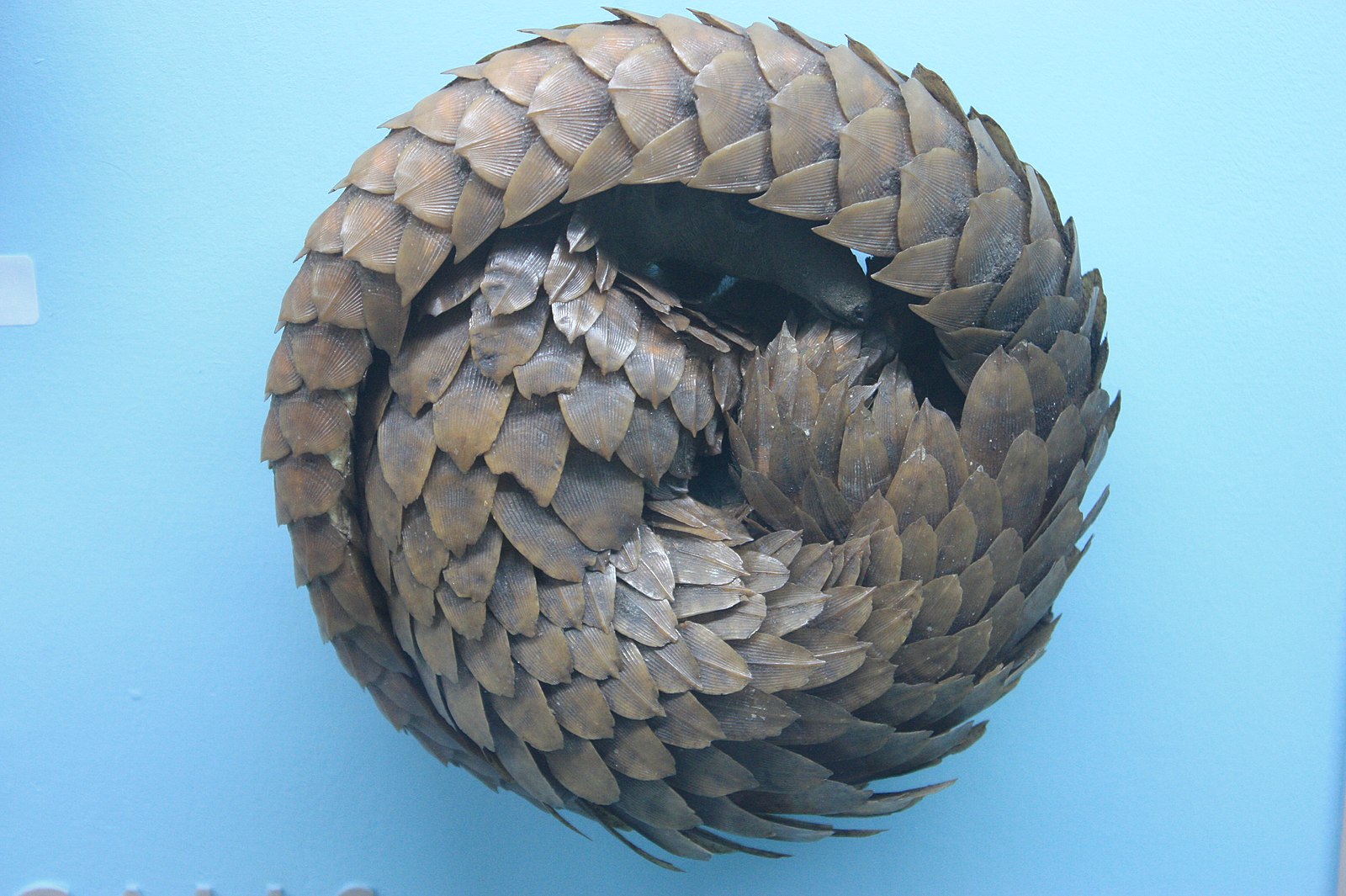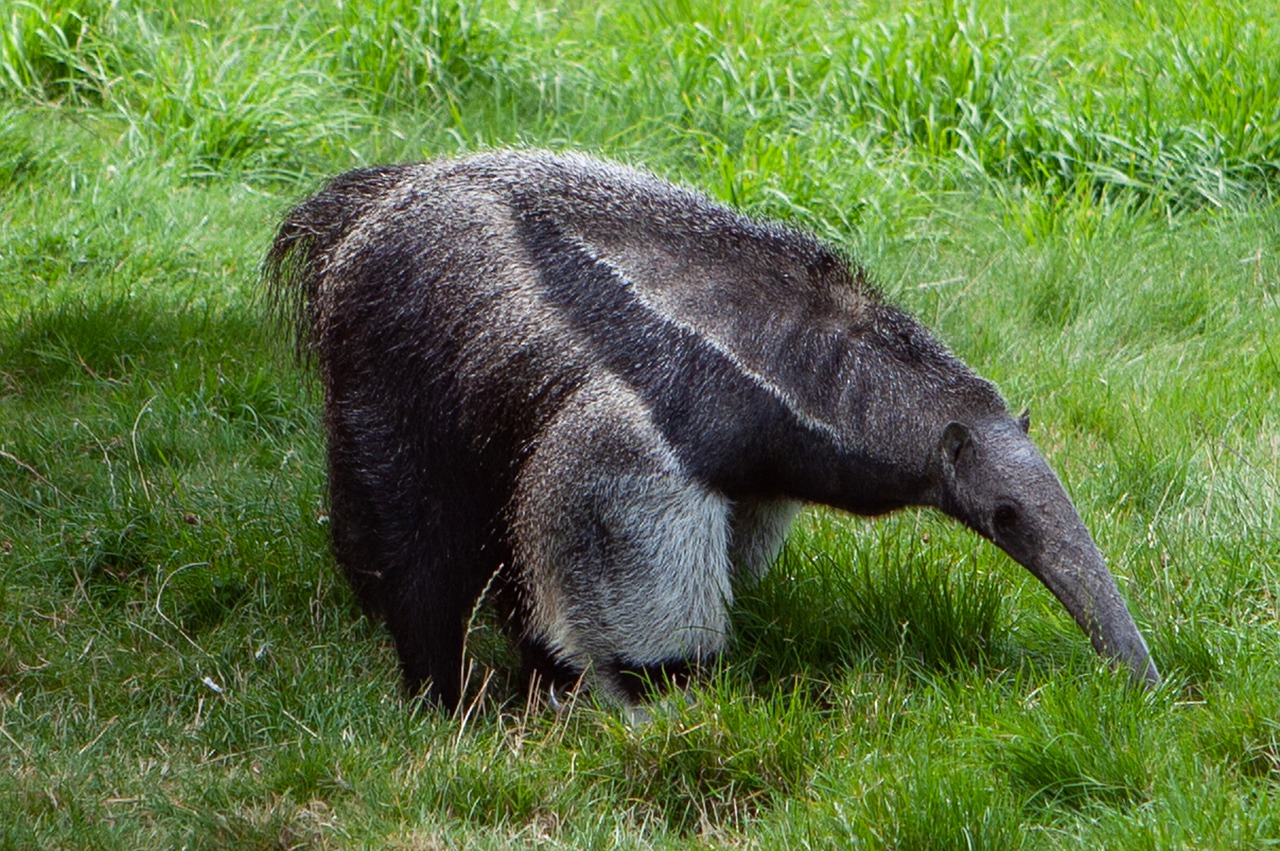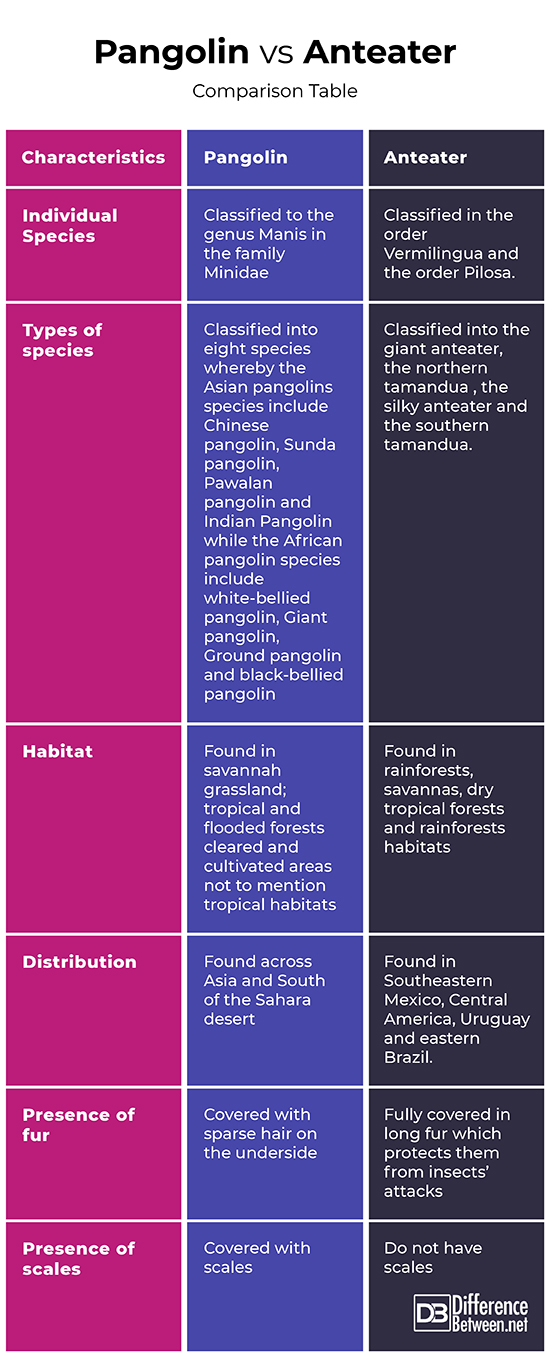Difference Between Pangolin and Anteater
The world currently has an approximate of 8.7 million species, among which 1.2 million constitute animal species. Among these, many are endangered, and their existence is threatened by different factors including overconsumption, habitat loss, pollution, loss of genetic variation and slow population growth. Pangolins remain the world’s most trafficked animals, with an estimate of only one million pangolins in the world. Although anteaters are not currently endangered, they have lost a great part of their population as a result of habitat destruction and hunting. Although the pangolin and anteater share similar traits, they have differences as outlined below.

All about Pangolin
Found across Asia and South of the Sahara desert, these are endangered insect easting mammals characterized by tough overlapping scales.
There are currently eight species of Pangolins, all belonging to the genus Manis in the family Minidae. This is the only family within the order Pholidota. Asian pangolin species include Chinese pangolin, Sunda pangolin, Pawalan pangolin and Indian Pangolin. African pangolin species include white-bellied pangolin, Giant pangolin, Ground pangolin and black-bellied pangolin.
The size of pangolins ranges between 1.6kgs to 33kgs, with overlapping scales, made from keratin, all over their bodies. The under sided however do not have scales but are covered with sparse hair. The only difference between the Asian pangolins and the African pangolins is the presence of bristles from between the scales in the Asian pangolins.
Pangolins are characterized with sticky tongues, perfect for lapping out ants, jaws lacking teeth and conical heads. Their tongues are attached near the last pair of ribs and pelvis and can be up to the length of the animal’s body and head when fully extended. They have stout limbs, adapted for digging, with each paw having five toes. Their forefeet have three curved and long claws used to dig sleeping and nesting burrows and demolish termite nests. They are also capable of swimming, with some species being adept climbers.
These species are found in savannah grassland; tropical and flooded forests cleared and cultivated areas not to mention tropical habitats. As far as the diet is concerned, pangolins mainly live on termites and ants but also feed on other invertebrates including flies, larvae, crickets, worms and earthworms. Their insatiable insects’ appetite plays an important role in the ecosystem through pest control.
They are highly sensitive, nocturnal and are solitary.

How about Anteater?
Found in Southeastern Mexico, Central America, Uruguay and eastern Brazil, this is a mammal species that feed mainly on ants and termites. They are closely related to the sloth and are classified in the order Vermilingua and the order Pilosa. Extract species include the giant anteater, the northern tamandua , the silky anteater and the southern tamandua.
They have a thin tongue, and an elongated snout with tube-shaped mouths, ideal for tearing and opening termite mounds as a defence mechanism. They also have long fur, which protects them from insects’ attacks.
Although all species feed on small insects, they have different preferences. While large species can penetrate nets of terrestrial insects, small species feed on arboreal insects on small branches. To hold insects together, their tongue is covered with thousands of tiny hooks, referred to as filiform papillae.
The anteaters reside in rainforests, savannas, dry tropical forests and rainforests habitats. They are solitary mammals, with an excellent sense of smell and poor sight.
Similarities between Pangolin and Anteater
- Both mainly feed on ants and termites
- Both have powerful digging forearms
- Both are toothless
- Both have long tongues
- Both have tube-like snouts
Differences between Pangolin and Anteater
Individual Species
Pangolins are classified to the genus Manis in the family Minidae. On the other hand, anteaters are classified in the order Vermilingua and the order Pilosa.
Types of species
Pangolins are classified into eight species whereby the Asian pangolin species include Chinese pangolin, Sunda pangolin, Pawalan pangolin and Indian Pangolin while the African pangolin species include white-bellied pangolin, Giant pangolin, Ground pangolin and black-bellied pangolin. On the other hand, anteaters are classified into the giant anteater, the northern tamandua, the silky anteater and the southern tamandua.
Habitat
Pangolins are found in savannah grassland; tropical and flooded forests cleared and cultivated areas not to mention tropical habitats. On the other hand, anteaters are found in rainforests, savannas, dry tropical forests and rainforests habitats.
Distribution
Pangolins are found across Asia and the South of the Sahara desert. On the other hand, anteaters are found in Southeastern Mexico, Central America, Uruguay and eastern Brazil.
Presence of fur
While pangolins are covered with sparse hair on the underside, anteaters are fully covered in long fur which protects them from insects’ attacks.
Presence of scales
Pangolins are covered with scales while anteaters do not have scales.
Pangolin vs. Anteater: Comparison Table

Summary of Pangolin vs. Anteater
While both pangolins and anteaters are toothless, have long tongues, have powerful digging forearms and mainly feed on ants and termites, pangolins are found in savannah grassland; tropical and flooded forests cleared and cultivated areas not to mention tropical habitats while anteaters are found in rainforests, savannas, dry tropical forests and rainforests habitats. Both are, however, rare species, with the pangolin being endangered while the anteaters have lost a great part of their population as a result of habitat destruction and hunting.
- Difference Between Profit Center and Investment Center - July 2, 2022
- Difference Between Anti-Trust and Anti-Competition - June 6, 2022
- Difference Between Stocktaking and Stock Control - June 6, 2022
Search DifferenceBetween.net :
Leave a Response
References :
[0]Alexander Caitlind. 14 Fun Facts About Anteaters: A 15-Minute Book. Learning Island Publishers. https://books.google.co.ke/books?id=OJaoAwAAQBAJ&pg=PT14&dq=anteaters&hl=en&sa=X&ved=0ahUKEwiP5biGg6DpAhUrzqYKHSB7Bw4Q6AEIaDAI#v=onepage&q=anteaters&f=false
[1]Alexander Caitlind. 14 Fun Facts About Anteaters: A 15-Minute Book. Learning Island Publishers. https://books.google.co.ke/books?id=OJaoAwAAQBAJ&pg=PT14&dq=anteaters&hl=en&sa=X&ved=0ahUKEwiP5biGg6DpAhUrzqYKHSB7Bw4Q6AEIaDAI#v=onepage&q=anteaters&f=false
[2]Chris Coggins. The Tiger and the Pangolin: Nature, Culture, and Conservation in China. University of Hawaii Press, 2003. https://books.google.co.ke/books?id=uAzyTcc52eMC&printsec=frontcover&dq=difference+between+pangolin+and+anteater&hl=en&sa=X&ved=0ahUKEwip0tSdgqDpAhVJcZoKHU_rCJYQ6AEITDAF#v=onepage&q=difference%20between%20pangolin%20and%20anteater&f=false
[3]Rebman Renee. Anteaters. Marshall Cavendish Publishers, 2006. https://books.google.co.ke/books?id=wcaSiELQsvQC&pg=PA8&dq=anteaters&hl=en&sa=X&ved=0ahUKEwiP5biGg6DpAhUrzqYKHSB7Bw4Q6AEIVzAG#v=onepage&q=anteaters&f=false
[4]Image credit: https://commons.wikimedia.org/wiki/File:A_pangolin_in_defensive_posture,_Horniman_Museum,_London.jpg
[5]Image credit: https://cdn.pixabay.com/photo/2019/08/22/14/05/giant-anteater-4423584_1280.jpg
